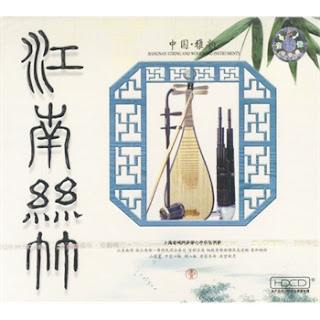Silk and Bamboo
Shanghai, a bridge, a park, a lotus pond, a pavilion. Lovers, couples, children and the elderly stroll past, others sitting on benches. Some exchange the latest gossip or news, while others observe courtships in the making or broken hearts. The wind carries up leaves and fallen willow, marking its course as it sails across the lotus pond. A solitary bird dips its head in the water. Music as the writer Indra Sinha reminds us ‘does not all have to be with strings and bows and pipes, it can also be made by drops of rain or wind cut by a leaf.’
I could tell you that silk and bamboo music is performed on bolts of silk in a bamboo grove or music of bygone dynasties performed by lithesome maidens for the emperor’s pleasure. It is in fact music that comes from the south of the Yangtze River. It is hugely popular in Shanghai but some of the repertory is staple for conservatory-trained musicians around the country. Silk refers to the string instruments that once had silk strings and the bamboo mostly flutes. The music includes percussion instruments, usually played by one musician holding a wooden clapper in his left hand and a drumstick in his right.
This afternoon I’m listening to silk and bamboo performed by a group of men in a pavilion. This is not a concert hall so there are no obligatory silences before or during a piece. Tables are full of tourists, Chinese and foreign, tea attendants running around filling pots of green tea. A piece ends and some of the musicians leave their places while others take their places. Above the constant chatter of voices, I hear the leading instruments, the bamboo flute and two-string spiked fiddle playing florid ornamented melodic lines, at times together, at times anticipated or delayed.
The homogeneous blend of instruments has a striking polyphonic texture with a strong harmonic feeling in the cadences even though I know that its musical architecture has no harmonic foundation. Its embroidered musical textures are what musicologists call heterophony. 'Hetero' means 'other' or 'different' and 'phony,' 'sound.' The texture present in many types of Chinese music, vocal and instrumental, has 'different sounds' or 'different voices,' but it would be more correct to say that there are different instruments performing the same tune at the same time. There are also heterophonic relationships between voice and accompaniment found in regional opera genres as well as Peking opera.
Heterophony in Chinese literally means 'branch-sound polyphony,' and it is often explained as Lawrence Witzleben points out, as 'resembling small branches of a river that continually diverge from the mainstream then return to it.' The branching tributaries analogy is pretty much what goes on when musicians decorate or ornament a melody, 'adding flowers' as it is described in Chinese, then bringing their oars back to join the other rowers. The ornamentations are never the same, and there are variations among performers.
I have always been fascinated by the changes that happen from one rendition to the next that are accepted within the tradition. More difficult to pin down, however, is trying to understand how the physical and mental state of the performer—that is—emotions ranging from happy sad to anxious and indifferent—influence the subtle execution of 'flowers.'
Any explanation will not be simple. Connections between music and mood are so idiosyncratic to make any explanation unsatisfactory. It’s a bit like asking a chef what he added to a dish that has transformed it into a dazzling culinary experience. I have not infrequently spoken to bamboo flute performers in the bamboo and silk tradition after a rendition of a piece and said: ‘I really like the way you added flowers in that piece', which is another way of saying, 'I really liked the way you added melodic ornamentations and used neighbouring passing pitches to create momentary deviation.' Whether it is a chef or a musician, what is made different or changes with each dish or the rendition of piece of music has become thoroughly internalized through years of practice. The intuitive stuff is never easy to pass on.
Variation is such an integral part of silk and bamboo music that transcriptions and published scores need to be handled with care,especially when so much of the spirit and nuances of the music are initially transmitted between teacher and student. The adding of flowers is what brings the tradition to life. It starts in a practice room with a notated score and teacher and incrementally blossoms into intuitive variation.
Lawrence


Comments
Post a Comment